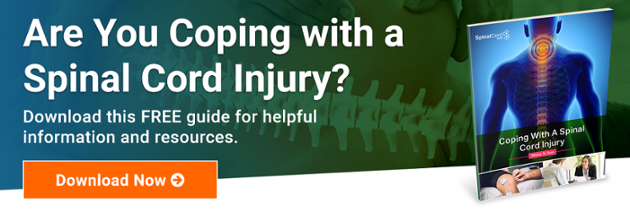What You Need to Know About Lumbar Spinal Cord Damage
Unlike a cervical spinal cord injury (SCI), damage to the lumbar spinal cord is severe but not necessarily life-threatening. The lumbar spine, which is located in the lower back below the thoracic spine, consists of five vertebrae (L1-L5, although some people are born with a sixth lumbar vertebra) and spinal cord tissue and nerves. Damage to this area of the spinal cord commonly affects the hip and leg regions of the patient.
Common causes of lumbar spinal cord damage include:
- Automobile accidents;
- Falls;
- Trauma;
- Degeneration;
- Osteoporosis; and
- Birth defects.
A lumbar spinal cord injury can be either complete or incomplete. This means that the injury either completely cuts off communication between the brain and the rest of the central nervous system or partially affects the transmission and receiving of messages but some function is still retained. Incomplete and complete injuries can occur at any level of the spinal cord, including the lumbar spine.
How does lumbar spinal cord damage affect your recovery and how you live your life?
What to Expect After a Lumbar Spinal Cord Injury
Every spinal cord injury is unique and differs in severity and effect. When someone suffers damage to the lumbar spinal cord, their injury may result in paraplegia with varying degrees of muscle sensation or function in the legs.
Some of the effects of a lumbar spinal cord injury include:
- Paraplegia with functional independence;
- Limited or full loss of sensation below the injury site;
- The need for a manual wheelchair (either for part-time or full-time use)
- Weakness, numbness, or loss of function in the hips, groin, and legs; and
- Loss of control of bladder and bowel functions.
The recovery process will depend on which spinal nerves are affected by the injury.
For example, damage to L1 and L2 can affect hip flexion, whereas L4 may affect the ability to bend your foot in an upward motion. An injury affecting L3-L5 can affect the hips and legs, causing numbness that extends down to the feet.
The spinal cord itself only extends part way down the length of the lumbar spine in the lumbar region, meaning that the lowest vertebral segment containing spinal cord tissue is L2.
Your Level of Independence After a Lumbar SCI
The good news is that many lumbar spinal cord injury survivors are able to remain independent and care for their own hygienic needs without assistance after treatment. Depending on the severity of their injury, some patients can manually operate their wheelchair or even walk for short distances with the help of braces or other assistive devices.
The Types of Treatments That Are Available
There is no one preferred or one-size-fits-all solution for treating a lumbar spinal cord injury — or any kind of SCI, for that matter. Treatment options depend on the health and condition of the patient, their goals, and what they are willing to do.
Surgery
The pressure around the spinal nerves can be reduced and the cord itself fixated through surgical decompression.
Rehabilitative Care
Physical and occupational therapy are common forms of treatment for individuals with lumbar spinal cord injuries.
Activity-Based Therapy
Activity-based therapy (ABT) is a therapeutic activity that is becoming increasingly common as a form of rehabilitative care for patients with spinal cord injuries. Much like physical therapy, ABT aims to help patients strengthen their bodies and improve their overall physical health.
Palliative Care
Some people with spinal cord injuries will use assistive devices to aid mobility and personal hygiene, and painkillers to help manage the pain from their injuries.
Experimental Treatments
There are several types of experimental treatments that are being explored as researchers seek to find a “cure” for spinal cord injuries and paralysis. These treatments can include stem cell injections, functional electrical stimulation (FES), and brain-computer interfaces.
Lumbar SCI Damage May Not Only Be Physical
The damage from spinal cord injuries can extend beyond the physical body. It’s not uncommon for people with spinal cord injuries at any level to experience feelings of depression as a result of their injury.
An SCI is a traumatic, life-changing experience that changes your life in real and significant ways. For some, they may experience loss of sensation or function below the site of the injury, may lose their ability to walk, which may mean they can no longer work or engage in the same hobbies or activities they enjoy.
A way to combat these negative feelings and emotions is to rely on your existing support system — your family, friends, and loved ones — or to develop a new one by finding companionship with other survivors in the SCI community.
If you’re seeking more information about coping with a spinal cord injury, be sure to check out our free resource guide by clicking on the banner below or contact us to speak to a specialist.
Stay Updated on Advancements On Traumatic Brain &
Spinal Cord Injuries
About the Author





